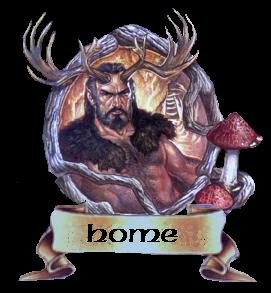|
Imbolc
Artist: Jonathon Earl Bowser - Used with
permission
February
2
Also
known as: Imbolic (Celtic), Imbollgc Brigantia (Caledonii),
Lupercus (Strega)
Imbolc,
also known as Candlemas, comes six weeks after Yule and six weeks
before the Spring Equinox. At this time, Witches honour the Celtic
Triple Goddess Brid (pronounced Breed) in her maiden aspect. Brid
or Brigid is goddess of fire, inspiration, healing, craftsmanship,
and midwifery. She is patroness of the hearth, poets, smiths,
craftspeople, healers, and priests.
Imbolc
is the winter Festival of Lights. It is the quickening of the
year, the first foetal stirrings of Spring in the womb of Mother
Earth. Spring lies within sight and the seed is prepared for
sowing. It is a fire festival, but emphasis is put on light rather
than heat -- light as it begins to pierce the gloom of winter.
February
2 is also Groundhog's Day (USA). The groundhog is a manifestation
of the God. He has been sleeping since Samhain and stirs in his
slumber to get a take on the coming light.
If
Candlemas day be sunny and bright, Winter again will show its
might.
If Candlemas day be cloudy and grey, Winter soon will pass away.
(Selena Fox)
(Author
Anonymous)
|
Back
to top
~~o00o~~
(containing
excerpts from Soctt Cunningham's Wicca: A Guide for the
Solitary Practioner)
A
symbol of the season, such as a representation of a
snowflake, a white flower, or perhaps some snow in a crystal
container can be placed on the altar. An orange candle
anointed with musk, cinnamon, frankincesne or rosemary oil,
unlit, should also be there. Snow can be melted and
used for the water during the circle casting.
Arrange
the altar, light the candles and censer, and cast the Circle
of Stones. If you wish you can recite a
Blessing Chant. Invoke the Goddess and God. Say
such words as the following: "This is the time
of the feast of torches, when every lamp blazes and shines
to welcome the rebirth of the God. I celebrate the
Goddess, I celebrate the God; All the Earth celebrates
Beneath its mantle of sleep."
Light
the orange taper from the red candle on the altar (or at the
Southern point of the circle). Slowly walk the circle
clockwise, bearing the candle before you. Say these or
similar words: "All the land is wrapped in winter.
The air is chilled and frost envelopes the Earth. But
Lord fo the Sun, Horned One of animals and wild places,
Unseen you have been reborn of the gracious Mother Goddess,
Lady of all fertility. Hail Great God! Hail and
welcome!"
Stop
before the altar, holding aloft the candle. Gaze at
its flame. Visualize your life blossoming with
creativity, with renewed energy and strength. If you
need to look into the future or past, now is an ideal time.
Works of magic, if necessary, may follow. Celebrate
the Simple Feast. The circle is released.
~~o00o~~
It
is traditional upon Imbolc, at sunset or just after ritual,
to light every lamp in the house - if only for a few
moments. Or, light candles in each room in honour of
the Sun's rebirth. Alternatively, light a kerosene
lamp with a red chimney and place this in a prominent part
of the home or in a window.
If
snow lies on the ground outside, walk in it for a few
moments, recalling the warmth of summer. With your
projective hand (the one you write with), trace an image of
the Sun on the snow.
Foods
appropriate to eat on this day include those from the dairy,
since Imbolc marks the festival of calving. Sour cream
dishes are fine. Spicy and full-bodied foods in honour
of the Sun are equally attuned. Curries and all dishes
made with peppers, onions, leeks, shallots, garlic or chives
are appropriate. Spiced wines and dishes containing
raisins - all foods symbolic of the Sun - are also
traditional.
|
|
Back
to top
~~o00o~~
Candlemas:
The Light Returns
(by
Mike Nichols)
It
seems quite impossible that the holiday of Candlemas should be
considered the beginning of Spring. Here in the Heartland,
February 2nd may see a blanket of snow mantling the
Mother. Or, if the snows have gone, you may be sure the days
are filled with drizzle, slush, and steel-grey skies -- the
dreariest weather of the year. In short, the perfect time for
a Pagan Festival of Lights. And as for Spring, although this
may seem a tenuous beginning, all the little buds, flowers and
leaves will have arrived on schedule before Spring runs its
course to Beltane.
'Candlemas'
is the Christianized name for the holiday, of course. The
older Pagan names were Imbolc and Oimelc. 'Imbolc' means,
literally, 'in the belly' (of the Mother). For in the womb of
Mother Earth, hidden from our mundane sight but sensed by a
keener vision, there are stirrings. The seed that was planted
in her womb at the solstice is quickening and the new year
grows. 'Oimelc' means 'milk of ewes', for it is also lambing
season.
The
holiday is also called 'Brigit's Day', in honor of the great
Irish Goddess Brigit. At her shrine, the ancient Irish capitol
of Kildare, a group of 19 priestesses (no men allowed) kept a
perpetual flame burning in her honour. She was considered a
goddess of fire, patroness of smith-craft, poetry and healing
(especially the healing touch of midwifery). This
tripartite symbolism was occasionally expressed by saying that
Brigit had two sisters, also named Brigit. (Incidentally,
another form of the name Brigit is Bride, and it is thus She
bestows her special patronage on any woman about to be married
or hand-fasted, the woman being called 'bride' in her honour.)
The
Roman Catholic Church could not very easily call the Great
Goddess of Ireland a demon, so they canonized her instead.
Henceforth, she would be 'Saint' Brigit, patron Saint
of smith-craft, poetry, and healing. They 'explained' this by
telling the Irish peasants that Brigit was 'really' an early
Christian missionary sent to the Emerald Isle, and that the
miracles she performed there 'misled' the common people into
believing that she was a goddess. For some reason, the Irish
swallowed this. (There is no limit to what the Irish
imagination can convince itself of. For example, they also
came to believe that Brigit was the 'foster-mother' of Jesus,
giving no thought to the implausibility of Jesus having spent
his boyhood in Ireland!)
Brigit's
holiday was chiefly marked by the kindling of sacred fires,
since she symbolized the fire of birth and healing, the fire
of the forge, and the fire of poetic inspiration. Bonfires
were lighted on the beacon tors, and chandlers celebrated
their special holiday. The Roman Church was quick to
confiscate this symbolism as well, using 'Candlemas' as the
day to bless all the church candles that would be used for the
coming liturgical year. (Catholics will be reminded that the
following day, St. Blaise's Day, is remembered for using the
newly blessed candles to bless the throats of parishioners,
keeping them from colds, flu, sore throats, etc.)
The
Catholic Church, never one to refrain from piling holiday upon
holiday, also called it the Feast of the Purification of the
Blessed Virgin Mary. (It is surprising how many of the old
Pagan holidays were converted to Maryan Feasts.) The symbol of
the Purification may seem a little obscure to modern readers,
but it has to do with the old custom of 'churching women'. It
was believed that women were impure for six weeks after giving
birth. And since Mary gave birth at the winter solstice, she
wouldn't be purified until February 2nd. In Pagan symbolism,
this might be re-translated as when the Great Mother once
again becomes the Young Maiden Goddess.
Today
this holiday is chiefly connected to weather-lore. Even our
American folk-calendar keeps the tradition of 'Groundhog's
Day', a day to predict the coming weather, telling us that if
the Groundhog sees his shadow, there will be 'six more weeks'
of bad weather (i.e., until the next old holiday, Lady Day).
This custom is ancient. An old British rhyme tells us that 'If
Candlemas Day be bright and clear, there'll be two winters in
the year.' Actually, all of the cross-quarter days can be used
as 'inverse' weather predictors, whereas the quarter-days are
used as 'direct' weather predictors.
Like
the other High Holidays or Great Sabbats of the Witches' year,
Candlemas is sometimes celebrated on it's alternate date,
astrologically determined by the sun's reaching 15-degrees
Aquarius, or Candlemas Old Style (in 1988, February 3rd, at
9:03 am CST). Another holiday that gets mixed up in this is
Valentine's Day. Ozark folklorist Vance Randolf makes this
quite clear by noting that the old-timers used to celebrate
Groundhog's Day on February 14th. This same displacement is
evident in Eastern Orthodox Christianity as well. Their habit
of celebrating the birth of Jesus on January 6th, with a
similar post-dated shift in the six-week period that follows
it, puts the Feast of the Purification of Mary on February
14th. It is amazing to think that the same confusion and
lateral displacement of one of the old folk holidays can be
seen from the Russian steppes to the Ozark hills, but such
seems to be the case! Incidentally, there is speculation among
linguistic scholars that the very name of 'Valentine' has
Pagan origins. It seems that it was customary for French
peasants of the Middle Ages to pronounce a 'g' as a 'v'.
Consequently, the original term may have been the French
'galantine', which yields the English word 'gallant'. The word
originally refers to a dashing young man known for his
'affaires d'amour', a true galaunt. The usual associations of
V(G)alantine's Day make much more sense in this light than
their vague connection to a legendary 'St. Valentine' can
produce. Indeed, the Church has always found it rather
difficult to explain this nebulous saint's connection to the
secular pleasures of flirtation and courtly love. For modern
Witches, Candlemas O.S. may then be seen as the Pagan version
of Valentine's Day, with a de-emphasis of 'hearts and flowers'
and an appropriate re-emphasis of Pagan carnal frivolity. This
also re-aligns the holiday with the ancient Roman Lupercalia,
a fertility festival held at this time, in which the priests
of Pan ran through the streets of Rome whacking young women
with goatskin thongs to make them fertile. The women seemed to
enjoy the attention and often stripped in order to afford
better targets.
One
of the nicest folk-customs still practiced in many countries,
and especially by Witches in the British Isles and parts of
the U.S., is to place a lighted candle in each and every
window of the house, beginning at sundown on Candlemas Eve
(February 1st), allowing them to continue burning until
sunrise. Make sure that such candles are well seated against
tipping and guarded from nearby curtains, etc. What a cheery
sight it is on this cold, bleak and dreary night to see house
after house with candle-lit windows! And, of course, if you
are your Coven's chandler, or if you just happen to like
making candles, Candlemas Day is THE day for doing it. Some
Covens hold candle-making parties and try to make and bless
all the candles they'll be using for the whole year on this
day.
Other
customs of the holiday include weaving' Brigit's crosses' from
straw or wheat to hang around the house for protection,
performing rites of spiritual cleansing and purification,
making 'Brigit's beds' to ensure fertility of mind and spirit
(and body, if desired), and making Crowns of Light (i.e. of
candles) for the High Priestess to wear for the
Candlemas Circle, similar to those worn on St. Lucy's
Day in Scandinavian countries. All in all, this Pagan Festival
of Lights, sacred to the young Maiden Goddess, is one of the
most beautiful and poetic of the year. |
|
Back
to top



|
|
|